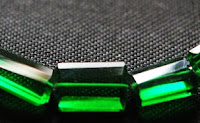HYDRO TOURMALINE?
 |
| "Rubellite Quartz" Hydro Stone |
I heard back from this person who informed me that her discussion group (well, one person) determined that there IS a "hydrothermal tourmaline" process, or a "hydrothermally stabilised tourmaline" which results in synthetic tourmaline, or some sort of hydrothermally enhanced tourmaline. I believe this person's response to me was to "inform" me that I was wrong, and her highly knowledgeable group was really right. I wondered why she even asked me in the first place... I stopped communication then, but I continued researching this subject---as anyone can easily do nowadays!
 |
| "Chrome Tourmaline Quartz" Hydro |
I googled "Hydrothermally stablised tourmaline", and there was only one result (on the discussion board). (This discussion group is on a highly regarded website for the sharing of information and opinions on jewelry. Anyone can join and anyone can post answers on the discussion board.) Despite calling it "hydrothermally stablized", this person was actually describing the "synthetic overgrowth" process of making synthetic emeralds and other stones. This isn't an enhancement, but a hydrothermal method to produce a new, synthetic gemstone. This involves taking a "seed" gem, and through pressure and heat in a solution, crystals grow around the center seed, forming a new stone surrounding the center seed. (I added a video below showing this process.)
But the trouble with this regarding tourmaline is that, despite anyone's assertions, there is absolutely NO synthetically grown tourmaline available. Enhanced gemstones are simply gemstones that have their color or clarity "enhanced" by various methods, and MUST be disclosed as enhanced: heated, irradiated, filled, oiled, dyed, etc. (Regarding enhanced tourmalines: they are frequently heated or irradiated, and sometimes "oiled" to enhance the colors and fill the imperfections.) There was a study done a few years ago (see here) regarding rumors and reality surrounding "synthetic tourmaline". And if you simply google "synthetic overgrowth" or "synthetic tourmaline" you can read many discussions about this, and they all say the same thing: no synthetic tourmaline gemstones are available. Labs try to create tourmaline, but the results are either extremely tiny stones or stones that "explode" or are otherwise not gem-quality. Even this discussion reveals that, per Tom Chatham (of Chatham Emeralds fame), there are no commercially available synthetic tourmaline stones. But that was from a few years ago. What about today? Has anything changed?
 |
| "Paraiba Quartz" Hydro |
I contacted the Gemological Institute of America myself, and asked if there are any synthetic tourmaline gemstones available as of 2015. I received a response and although I'm not able to post the response here (it's considered private between the GIA and me), they told me that, despite many attempts at synthesizing tourmalines, there are no gem-quality synthetic tourmalines available in the market today, nor is it economically feasible to produce gem-quality tourmalines. This was as of June 10, 2015.
So going back to the convo on Etsy---despite what this person's online group member said, and despite the claim of a seller somewhere offering "hydro tourmaline", the stones they would buy would test as either "hydro quartz" that is simply the color of a tourmaline, some other synthetic or even natural stone that looks like tourmaline, or possibly glass (see below). Maybe they would receive an oil-enhanced tourmaline, but in that case, it would be just a tourmaline that has been enhanced (and must be disclosed as enhanced), not a "hydro tourmaline". Perhaps in the future there will be synthetic tourmalines, but there are no gem-quality synthetic tourmalines being sold as of today. PERIOD.
This experience with the Etsy "convo" reminded me of Isaac Asimov---do you want the answer that is true, or the answer that satisfies? They are often not the same.
Well, I prefer the truth. And buyers deserve the truth.
Here's an interesting video from Tairus, a company that makes incredibly beautiful synthetic emeralds using the hydrothermal method (plus sapphires, rubies, beryl, and alexandrite):
*********************************
HYDRO QUARTZ
 |
| Synthetic Amethyst |
I recently purchased some "hydro quartz" on Etsy from a couple of different gemstone sellers. I bought the same color of deep "tourmaline pink" (like rubellite). They arrived and look absolutely beautiful---the colors are rich and vibrant (each stone, although from different sellers, was EXACTLY the same color of pink), and the stones are clear and free of obvious bubbles, which would be found in glass. Even looking through a 10x loupe, the stones look nice. The surface on one set of stones had a sort of "orange peel" look, very slight, which made me wonder if it was coated. The faceting on all the stones wasn't quite as sharp or defined as I had hoped. I did the "scratch test" on glass, and one stone felt like it was scratching the glass, but I couldn't find any mark. The other stones just slid over the glass. None of the stones themselves were harmed. So my own examination didn't really tell me anything.
I took them to a certified gemologist to have them checked last week, to verify if these are quartz, or glass. The gemologist used various methods to check all the stones, and then told me they were NOT quartz, but were glass. All of them were glass.
This is not to say that the Etsy sellers are trying to defraud anyone. But they purchase their stones for resale from gem dealers in India or China or Thailand---wherever these so-called hydro quartz stones are made---as hydro quartz, and then they sell them to jewelry designers, and so on down the line, until now, the market is saturated with glass stones sold as quartz, as well as some actual hydro quartz. You really can't tell the difference without having the stones tested, and not many people will bother taking them to a gemologist for testing.
So that was MY very recent experience with "hydro quartz" from Etsy: just very pretty glass that looks like quartz (or even tourmaline). No problem----I'll wear it myself!








